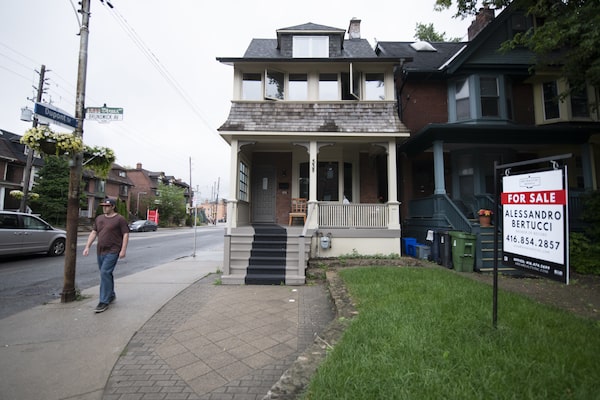
A home for sale in Toronto’s Annex neighbourhood on July 18.Fred Lum/The Globe and Mail
Canada’s average home price could drop by as much as 25 per cent from peak values in February by the end of next year, with the Maritimes and most of Ontario shouldering greater declines owing to the sharp jump in borrowing costs, says a new private-sector forecast.
Since the Bank of Canada started raising interest rates in March to rein in inflation, the country’s housing market has slowed considerably. Sales volumes have plummeted, and the average home price is down 18.5 per cent from February to June, according to Canadian Real Estate Association data.
Consequently, the Desjardins Group said it has had to drastically revise its forecast because the market was correcting faster than it had anticipated. In June, Desjardins economists predicted a 15-per-cent decline in the average price from February to the end of 2023. Now, Desjardins expects a decline of 20 per cent to 25 per cent.
That is the most bearish outlook among private-sector economists, who have been predicting declines of 10 per cent to 20 per cent.
“Home prices continue to fall and have further to go before they find a bottom,” Desjardins economists said in a research note.
When will Canadian home prices bottom? Here are some clues
As a shifting market gives buyers more power, galvanized sellers push prices lower
Bank of Canada’s ‘soft landing’ scenario hits the rocks in bond market
Desjardins said the central bank is raising rates more aggressively than anticipated, which will continue to increase borrowing costs. The Bank of Canada’s benchmark interest rate is now 2.5 per cent, up from 0.25 per cent earlier this year. With inflation clocking in at 8.1 per cent in June, the bank is expected to continue to raise interest rates.
Desjardins sees the bank hiking rates to as high as 3.25 per cent later this year. That will make it costlier for people with a variable-rate mortgage. Fixed mortgage rates are double what they were a year ago.
Most economists agree that areas that saw the biggest price gains during the first two years of the pandemic are likely to see the largest declines. That has already started to occur in some parts of the country, such as certain Toronto suburbs and smaller Ontario cities, where home prices rose more than 80 per cent from 2020 through early 2022.
Desjardins said the shift away from full-time telework to a gradual return to the office will make it more difficult to live in relatively affordable regions of the country such as the Maritimes. It predicts the average home price will drop as much as 29 per cent in New Brunswick, 27 per cent in Nova Scotia, 25 per cent in Prince Edward Island and 11 per cent in Newfoundland and Labrador.
In Ontario, it expects an average price decline of 24 per cent, with values falling 22 per cent in Toronto and 27 per cent in the rest of the province. It predicts prices will fall 22 per cent in British Columbia, 17 per cent in Quebec and 14 per cent in Manitoba, with Alberta and Saskatchewan seeing just single-digit declines.
Your time is valuable. Have the Top Business Headlines newsletter conveniently delivered to your inbox in the morning or evening. Sign up today.
 Rachelle Younglai
Rachelle Younglai